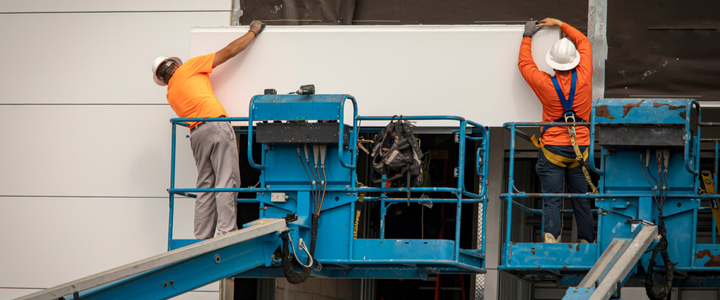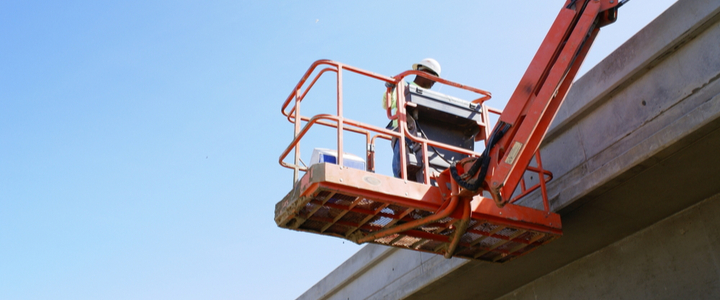Manlifts or boom lifts are efficient ways for one man to get up high in a short amount of time. First, however, your team needs to understand the OSHA manlift requirements and understand how to use the device safely. This is a guide that will help you understand the top boom lift safety requirements.
Safety Rules For Operating Manlifts
There will always be boom lift hazards, but you can limit the risks by following these safety tips. You should make sure that the people who are operating the device have manlift safety training. Here are the top six safety tips we can give you.
1. Verify That Employees Are Trained & Certified
Every person who uses and operates the manlift needs to be fully trained before ever touching the machinery. This will help limit hazards and risks but also ensure you follow OSHA regulations. In addition, each person will need to be certified in using a boom lift. If your workers are not certified, they should not be allowed to control or use the boom lift.
2. Check the Manlift Inspection Record
You should not only look through the records, but you should also look at the vehicle itself. Check the records for any previous problems or things that did not get checked off. Before ever using the boom lift, you should always look at the emergency controls, operating controls, outriggers, guardrails, and tires. There should be no leaks in fuel, air, or hydraulic fuel. If something is not working properly or has been recorded not working, do not use the manlift.
3. Use the Proper Safety Gear
No one can go into a manlift without the proper gear. Not wearing the appropriate equipment can lead to severe injuries that leave your team in danger. A manlift harness provides safety while up high and ensures that operators will not drop or hit the ground if they fall. It is an added layer of protection.
4. Inspect Your Surroundings
The most crucial thing to be aware of is the surroundings and where you put the manlift. You will need to pay attention to slopes, hills, bumpy pavement, and even the weather. If it is super windy, you may not be able to use the manlift. The surroundings you are in play a huge role in how safe the operation is.
5. Never Exceed the Weight Limit
One of the best boom lift safety tips we can give you is never to exceed the weight limit. You will have to look in the manual for the manlift, stating the weight limit. You may be able to only send one or two people up at one time, but you should never send more than what the manlift can carry.
6. Follow Correct Shutdown Procedures
You will need to understand what the shutdown procedure is and ensure that every team member operating the manlift knows it. This should be a part of the training process. Many people who have certificates to operate one will know how to do the proper shutdown procedure.

Common Manlift Hazards
Manlifts can be dangerous but sometimes are necessary to get a job done. Some of the most common hazards include falling, electric shock, falling options, collapse, and even tip-overs. Using a harness can be crucial if someone does fall, and inspections are essential before stepping foot in a manlift.
Tip-overs can happen when the manlift is placed on a hill or slope; it’s vital to inspect the surroundings of a worksite. Anything falling or pushing the manlift could be a result of wind. That is why there are OSHA manlift wind restrictions that you need to follow.
Manlift Inspection Tips
Firstly, manlifts should be inspected every month and before use. You should always have the manufacturing manual nearby. You will need to check the rails, belt and belt tension, floor landings, check the lights, and check the horns.
One of the most important things you can check before operating is the brakes and gears. There should also be safe emergency exit ladders and even a fire extinguisher in case of emergencies.
What Not To Do When Operating a Manlift
When you are operating a manlift, there are some things you should not do. For example, you should not use it when it is too windy; this can be a dangerous environment to work in. Also, no one in the manlift should lean or sit on the rails or the platform. Most importantly, do not forget to wear your safety gear.

OSHA Manlift Requirements
OSHA manlift safety requirements state that if any part of the manlift is at risk of becoming a hazard, it will not be used. This means if anything is missing or it is deemed unsafe, no one can use it. One designated person will be responsible for checking the manlift every 30 days, and limit switches will be checked weekly. Everything should be recorded to track any changes in a lift.
Avoid Manlift Safety Hazards with Training from Safety By Design
Safety By Design ensures that you know exactly what to expect when you start training your team about manlifts. Our Houston safety consultants will help you develop a detailed plan on how to effectively train your team and give you the best training tips.
Contact us online today to schedule a consultation for your workplace safety.



